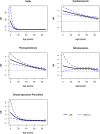Oral Antibiotic Exposure and Kidney Stone Disease
- PMID: 29748329
- PMCID: PMC6054354
- DOI: 10.1681/ASN.2017111213
Oral Antibiotic Exposure and Kidney Stone Disease
Abstract
Background Although intestinal and urinary microbiome perturbations are associated with nephrolithiasis, whether antibiotics are a risk factor for this condition remains unknown.Methods We determined the association between 12 classes of oral antibiotics and nephrolithiasis in a population-based, case-control study nested within 641 general practices providing electronic health record data for >13 million children and adults from 1994 to 2015 in the United Kingdom. We used incidence density sampling to match 25,981 patients with nephrolithiasis to 259,797 controls by age, sex, and practice at date of diagnosis (index date). Conditional logistic regression models were adjusted for the rate of health care encounters, comorbidities, urinary tract infections, and use of thiazide and loop diuretics, proton-pump inhibitors, and statins.Results Exposure to any of five different antibiotic classes 3-12 months before index date was associated with nephrolithiasis. The adjusted odds ratio (95% confidence interval) was 2.33 (2.19 to 2.48) for sulfas, 1.88 (1.75 to 2.01) for cephalosporins, 1.67 (1.54 to 1.81) for fluoroquinolones, 1.70 (1.55 to 1.88) for nitrofurantoin/methenamine, and 1.27 (1.18 to 1.36) for broad-spectrum penicillins. In exploratory analyses, the magnitude of associations was greatest for exposure at younger ages (P<0.001) and 3-6 months before index date (P<0.001), with all but broad-spectrum penicillins remaining statistically significant 3-5 years from exposure.Conclusions Oral antibiotics associated with increased odds of nephrolithiasis, with the greatest odds for recent exposure and exposure at younger age. These results have implications for disease pathogenesis and the rising incidence of nephrolithiasis, particularly among children.
Keywords: antibiotic; kidney stones; microbiome.
Copyright © 2018 by the American Society of Nephrology.
Figures



Comment in
-
Does the Receipt of Antibiotics for Common Infectious Diseases Predispose to Kidney Stones? A Cautionary Note for All Health Care Practitioners.J Am Soc Nephrol. 2018 Jun;29(6):1590-1592. doi: 10.1681/ASN.2018040402. Epub 2018 May 10. J Am Soc Nephrol. 2018. PMID: 29748328 Free PMC article. No abstract available.
-
The link between antibiotic exposure and kidney stone disease.Ann Transl Med. 2018 Sep;6(18):371. doi: 10.21037/atm.2018.07.23. Ann Transl Med. 2018. PMID: 30370298 Free PMC article. No abstract available.
-
Re: Oral Antibiotic Exposure and Kidney Stone Disease.J Urol. 2020 Aug;204(2):373. doi: 10.1097/JU.0000000000001108.03. Epub 2020 May 14. J Urol. 2020. PMID: 32407204 No abstract available.
References
-
- Tavichakorntrakool R, Prasongwattana V, Sungkeeree S, Saisud P, Sribenjalux P, Pimratana C, et al. .: Extensive characterizations of bacteria isolated from catheterized urine and stone matrices in patients with nephrolithiasis. Nephrol Dial Transplant 27: 4125–4130, 2012 - PubMed
Publication types
MeSH terms
Substances
Grants and funding
LinkOut - more resources
Full Text Sources
Other Literature Sources
Medical

